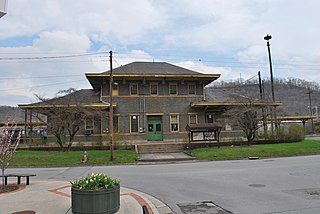
Karst is a topography formed from the dissolution of soluble rocks such as limestone, dolomite, and gypsum. It is characterized by underground drainage systems with sinkholes and caves. It has also been documented for more weathering-resistant rocks, such as quartzite, given the right conditions. Subterranean drainage may limit surface water, with few to no rivers or lakes. However, in regions where the dissolved bedrock is covered or confined by one or more superimposed non-soluble rock strata, distinctive karst features may occur only at subsurface levels and can be totally missing above ground.

Monroe County is a county in the U.S. state of West Virginia. As of the 2020 census, the population was 12,376. Its county seat is Union.

Ronceverte is a city in Greenbrier County, West Virginia, United States, on the Greenbrier River. The population was 1,765 at the 2010 census.

Durbin is a town in Pocahontas County, West Virginia, United States. The population was 293 at the 2010 census.

The Greenbrier River is a tributary of the New River, 162 miles (261 km) long, in southeastern West Virginia, in the United States. Via the New, Kanawha and Ohio rivers, it is part of the watershed of the Mississippi River, draining an area of 1,656 square miles (4,290 km2). It is one of the longest rivers in West Virginia.

Cass Scenic Railroad State Park is a state park and heritage railroad located in Cass, Pocahontas County, West Virginia.
West Virginia Route 12 is a north–south route located in the southern portion of the U.S. state of West Virginia. The southern terminus of the route is at U.S. Route 219 in Peterstown, Monroe County, less than 300 yards (270 m) from the Virginia state line. It compromises a portion of the Farm Heritage Road byway between Peterstown and West Virginia Route 122. The northern terminus of the route is at U.S. Route 60 in Alta, Greenbrier County, near Interstate 64 exit 161.

The Cranberry River is a tributary of the Gauley River located in southeastern West Virginia in the United States. It is a part of the Mississippi River watershed, by way of the Gauley, Kanawha, and Ohio Rivers, draining an area of 74 square miles (192 km2).

The Greenbrier River Trail (GRT), is a lineal state park comprising a 77.1-mile (124.1 km) rail trail between North Caldwell and Cass in eastern West Virginia.
The West Virginia spring salamander is a species of salamander in the family Plethodontidae. It is endemic to West Virginia, the United States.

The Durbin and Greenbrier Valley Railroad is a heritage and freight railroad in the U.S. states of Virginia and West Virginia. It operates the West Virginia State Rail Authority-owned Durbin Railroad and West Virginia Central Railroad, as well as the Shenandoah Valley Railroad in Virginia.

Pence Springs is an unincorporated community in Summers County, West Virginia, United States. It lies along the Greenbrier River to the east of the city of Hinton, the county seat of Summers County. Its elevation is 1,539 feet, and it is located at 37°40′41″N80°43′30″W. It had a post office with the ZIP code 24962 until it was closed in October 2011.
The West Virginia Speleological Survey (WVaSS) is a speleological organization and ongoing cave survey program that has gathered information and published about West Virginia caves and karst since 1967.
Fort Spring is an unincorporated community and town in Greenbrier County, West Virginia, United States. It is situated along the Greenbrier River within the Greenbrier River Watershed. It was once a substantial portion of the Chesapeake and Ohio railway by way of the Gravel Girtie route from Hinton in Summers County to Clifton Forge, Virginia. The name is derived from its main export; Mississippian limestone from Snowflake Quarry sent to Clifton Forge. The main road going through the small town was once the original rail line, but was moved.
Clayton is an unincorporated community in Summers County, West Virginia, United States. The community was first settled in 1813. Clayton once had a post office, which opened in 1879 and closed in 1959.
Haynes Cave is a cave within the Greenbrier River watershed in West Virginia. It sits within the complex hydrology of the historic Second Creek watershed in Monroe County.
The St. Lawrence Boom and Manufacturing Company was a lumber company based in Ronceverte, West Virginia. It was founded in 1802 by a Colonel Cecil C. Clay, a former US Army Brigadier-General from Philadelphia.
Lowell is an unincorporated community in Summers County, West Virginia, United States. Lowell is located on the Greenbrier River, east of Hinton and southwest of Alderson. The community was first settled in 1770 and is the oldest community in Summers County.

Sinks Grove is an unincorporated community in Monroe County, West Virginia, United States. Sinks Grove is located on West Virginia Route 3, north of Union. Sinks Grove has a post office with ZIP code 24976.
Thornwood is an unincorporated community in Pocahontas County, West Virginia, United States. Thornwood is on the East Fork of the Greenbrier River. US Route 250 passes approximately one-half mile to the south. It is approximately 5 miles (8.0 km) east-northeast of Durbin.











